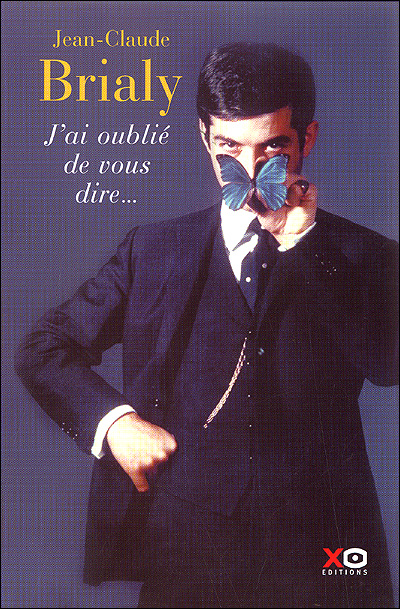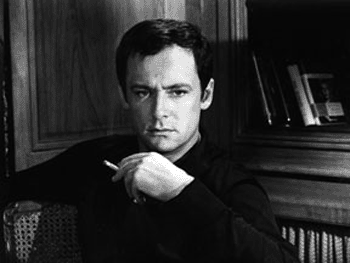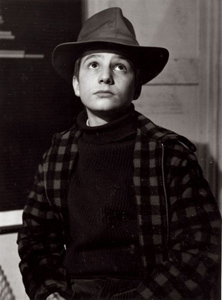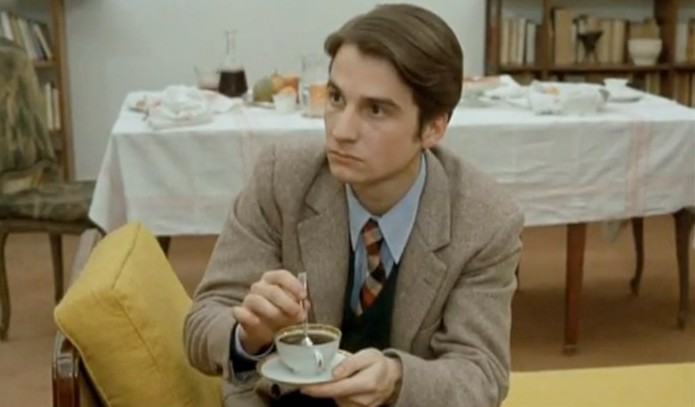 French New Wave Dandy Style: Cool Glamour and Urban Socialites
French New Wave Dandy Style: Cool Glamour and Urban SocialitesElements of French New Wave Dandy Style
Clothes:
cream, brown, gray, or navy tailored three-piece suit

skinny tie

bright or black poloneck or turtleneck sweater
patterned or pinstriped shirt
cufflinks and watch fobs
cream, gray, or brown slacks in wool or cotton
loafers or winkle pickers
Hair:
neat and perfectly coiffed
Cologne:
Le Dandy Pour Homme by D'Orsay
French Lover (aka Bois d'Orage), by Frederic Malle -- nephew of Louis Malle
Attitude:
witty, sophisticated, cynical, urbane, laid-back, fatalistic
Jean-Claude Brialy
The arrival of the Nouvelle Vague in the late 1950s heralded the arrival of a clutch of dazzling new female stars including Brigitte Bardot, Jeanne Moreau andJean Seberg. With their cool sexiness and modern way of talking and behaving, they would become the emblems of this audacious new cinema, helping to popularize it around the world. At the same time a group of actors, contemporaries and friends of the directors spearheading the movement, proved that they could be equally as glamourous, without sacrificing their masculinity. These "dandies" had a fresh look and an acting style that embodied the ideological and cinematic goals of the New Wave.
One of the most distinctive examples of this new breed of actor was Jean-Claude Brialy. Relaxed, seductive, and charming, Brialy was the epitome of suave sophisticate, the debonair playboy, the urbane socialite with a dark streak. He personified a certain kind of devil-may-care dandyism associated with an older generation of libertarian writers who fascinated the young New Wave directors. Onscreen, in films like Les Cousins (1958), Le Bel age (1960), Une femme est une femme (1961), and Le Genou de Claire (1970), Brialy always appeared effortlessly stylish, whether sporting an elegant suit and tie, polo neck, blazer and scarf, or bohemian straw hat and open neck shirt. Off-screen he was celebrated for being a brilliant raconteur, an accomplished stage performer and a restaurant owning bon viveur.

Maurice Ronet
Another actor who combined a certain world-weary detachment with sophisticated elegance was Maurice Ronet. With a screen persona somewhere between a French James Bond and a doomed character from an F. Scott Fitzgerald story, Ronet specialized in playing romantic loners with a fatalistic outlook. In his greatest role, Louis Malle’s Le Feu Follet (1963), he played a world-weary alcoholic who has decided to commit suicide but visits his friends in Paris one last time in an attempt at finding a reason to continue living. With his wry smile, elegant apparel and soft-spoken charm, he has the kind of charisma that most men only dream about, and yet, impressing others has little value for him. He represents the dandy in hell – a wounded soul, weary of a world that has failed to live up to his expectations.
Not all the New Wave directors, however, viewed the decadent and the dandy with such admiration. In Alain Robbe-Grillet and Alain Resnais’ L’Année dernière à Marienbad (Last Year in Marienbad, 1961), the elite social gathering of idle rich who waft around the Chateau setting in which the film takes place, appear, at best, well-dressed mannequins, and at worst, decidedly sinister figures. Meanwhile Eric Rohmer, exercising a very different political and stylistic perspective, frequently features in his moral comedies, womanizing scoundrels forced to confront their misdeeds and question their arrogant self-belief.

The Truffaut-esque Hero: Antoine Doinel and Other Sensitive Rebels
Elements of Antoine Doinel Style
Clothes:lumberjack jacket
 , battered brown leather jacket, or pea coat slightly scruffy V-neck vintage sweaters in bright colours or black brightly coloured scarves or ties
, battered brown leather jacket, or pea coat slightly scruffy V-neck vintage sweaters in bright colours or black brightly coloured scarves or tiestweed jacket battered fedora or trilby - or no hat at all.
Hair:perpetually rumpled, or long and flowing Cologne:'Anarchiste by Caron The Dreamer
 by Versace Attitude:poetic, rebellious, quirky, imaginative, romantic, boyish, troubled, charming
by Versace Attitude:poetic, rebellious, quirky, imaginative, romantic, boyish, troubled, charming |
| Jean-Pierre Leaud in Les Quatre cents coups (1959) |
Like any true auteur Francois Truffaut never failed to put his own personal stamp on his movies. The heroes of his films, in particular, reflected many of his own personality traits, none more so than the autobiographical figure of Antoine Doinel who first appeared in Les Quatre cents coups (The 400 Blows, 1959). Like those other great fictional teen rebels of the 1950s – Holden Caulfield and Jim Stark – Doinel is a bundle of contradictions: sensitive yet anti-authoritarian, intelligent yet inarticulate, daring yet indecisive. He longs for adult approval but cannot stop getting into trouble.
A large part of Antoine Doinel’s appeal lay in the looks, manner and style of the actor who played him. Onscreen Jean-Pierre Léaudmanaged to project defiance and vulnerability in equal measure. His deadpan solemnity, reminiscent of a silent movie comedian, and his instinctive, in the moment commitment to whatever situation the character was in, made him seem authentic – sometimes funny, sometimes frustrating, always real. In Les Quatre cents coups, his distinctive look – spiky hair, lumberjack coat and polo neck sweater – marked him out as both an outsider and a fashion influence. Punk pioneer Richard Hell was so inspired by the young Doinel he based his “blank generation” look on him; a look, which in turn influenced other musicians and legions of disaffected youth.
Jean-Pierre Leaud thoughtfully prepares a cup of tea.
In the later films Antoine smartens up but retains a consistent air of dishevelment in keeping with the turbulent emotions smouldering beneath the surface. While on the surface his appearance conforms perfectly with our idea of a stylish young Parisian of the time, there is, at the same time, something old fashioned in his dress and way of acting. This is no accident. As Truffaut himself explained in his forward to the published Doinel scripts:
“It is precisely because of his anachronism and romanticism that I found Jean-Pierre so appealing. He is a young man of the nineteenth century. As for myself, I am a nostalgic. I am not tuned in on what is modern, it is in the past that I find my inspiration”.
No wonder then that he returned again and again in his films to period settings or that, even in his contemporary films, his leading protagonists seem to have stepped out of an earlier more sincere and romantic era.

No comments:
Post a Comment